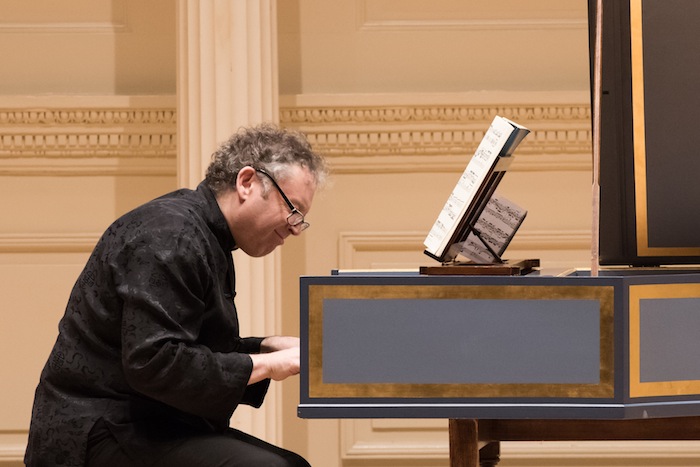Egarr’s remarkable artistry opens door to fascinating musical world

Richard Egarr performed Thursday night at Zankel Hall. File photo: Nan Melville
The modern piano, with its dynamic range, brilliance, and power, is indisputably the most important instrument in classical music.
But it’s no harpsichord. It’s also no clavichord, spinet, organ, or clavicytherium. The equal-tempered tuning system it ushered in is often inadequate for realizing keyboard music from earlier periods.
The uniformity and predictability of the piano made those original keyboard instruments impractical, then mostly extinct. But some magic has been lost—not just the colors of instruments like the harpsichord, but regional and national variations in style, sound, and tuning.
In a performance Thursday night at Weill Recital Hall, Richard Egarr revealed some of the wonders of this music. Egarr played about a dozen short pieces from five composers, a tiny sliver from the massive collection of the Fitzilliam Virginal Book. The virginal was another early keyboard instrument, meant for the home, and the book a collection of keyboard pieces, primarily from English composers.
Egarr played music by Byrd, Purcell, Thomas Morley, John Blow, and the Dutch composer Jan Pietersoon Sweelinck, an important influence on his contemporaries and those that followed. The material showed off some of the brilliance of musical thinking in the late Renaissance and early Baroque eras in general, and that of Egarr’s instrument in particular.
He played what he described in his relaxed, informative introductions from the stage, as an 18th-century French instrument that was tuned—in the first half—to a meantone temperament prevalent in the 17th century. The combination of the two was wonderful, like seeing the details and colors of a familiar but now restored painting.
The instrument had a subtle, rounded, elegant yet rich sound. That was pleasurable enough, but the tuning uncovered a deeper layer of excitement and satisfaction. Briefly, meantone placed primacy on the third, rather than the fifth, and split the difference on intervening intervals like the second. The result was a tuning that emphasized a powerful and dramatic relationship between major and minor keys, kept modulations close to home, and was almost embarrassingly rich in expressive chromaticism.
Egarr apologized to the audience ahead of time, in case the tuning made anyone queasy. Quite the contrary; hearing what amounted to microtonal intervals packed through pieces like Sweelinck’s dazzling, improvisatory Fantasia chromatic, SwWV 258, was exhilarating, like sliding into cool water and being carried smoothly along by the current.
The music exploded with character under Egarr’s hands and through the instrument. His playing was fluid and assured all evening, with what seemed the perfect application of rubato in individual measures and across longer phrases. He used the two manuals of his harpsichord for changes in tone color and dynamics that were all the more effective for their subtlety.
The nature of the piano would put the emphasis on the structural thinking in pieces like Byrd’s The Bells, while harpsichord showed what a tremendous masterpiece it is. The representation of tolling bells was both poetic representation and a structural ground on which Byrd built a dancelike set of marvelous variations. Egarr’s playing explored both the intellectual and aesthetic beauty in the music.
Fantasy and dance were the two themes, form and improvisation. In Fantasias from Sweelinck and Byrd, and Morley’s Variations on the song “Goe from my window,” Egarr channeled life through the music, an in-the-moment feeling of ornamentation and invention. In Byrd’s Pavan and Galliard, No. 3, MB 16a/b, and the Grounds heard in the second half, Egarr’s steady pulse and dignified rhythms reached deep into the soul.
At intermission, Egarr retuned the harpsichord to proportions more appropriate to the music of the second half, mainly Purcell, augmented by his teacher John Blow. Born more than 100 years after Byrd, Purcell composed during a period where tuning systems were inexorably moving toward equal temperament. Still, there were plenty of delicious, expressive chromatic intervals.
In fact, these stood out more prominently in the context of the Apollonian beauty and profound emotion in Purcell’s keyboard pieces.
Surrounding two rich, energetic suites from Blow, Egarr alternated Suites and Grounds from the younger composer. The formal clarity of each Suite set off the wrenching emotions the flowed from the Grounds. The performances of “A New Ground,” Z. 682, which responds to Purcell’s own “Dido’s Lament,” and the scintillating chromatic repetitions of the Ground in D Minor, ZD. 222, which ended the concert, were enthralling and deeply felt.
Called back for an encore, Egarr played Froberger’s Lamenta Sopra la dolorosa perdita di Ferdinand IV. Music meant to honor the dead, Egarr dedicated the performance to his own teacher, the mighty Gustav Leonhardt. Egarr will play the same piece Monday in Amsterdam, at a ceremony to honor the fifth anniversary of Leonhardt’s passing.
“La Serenissima,” Carnegie’s festival of music and arts from the Venetian Republic, beginsFebruary 3 carnegiehall.org
Posted Jan 14, 2017 at 3:46 am by Reinhard von Nagel
Clear and competent. Wonderful. Thank you.